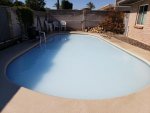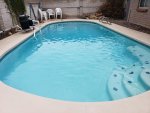About a year ago I spent several days, and many note pads, working out the lime-softening process for my pool. IN the end, the cost of the chemicals involved plus all of the convoluted steps needed to make it work without scaling my pool walls with calcium was just not worth it. Lime-softening is a great treatment process for potable water distribution systems, not so much for swimming pools. As for RO, most of the companies around here use cheap, low pressure RO systems that would be lucky to get you a 25% waste fraction....and most of the vendors I talked to stopped doing RO because it was too expensive to keep up the equipment. Even at a cost of $600, I could fully drain and refill my pool as well as get the tiles cleaned for less.
I've managed my water all the up to a CH of 1500ppm, not fun but doable. At the end of the day, the most cost effective solution was adding a whole-house water softener to my home with a line connected to the autofill. With partial drains and refills plus a steady diet of zero CH fill water, my pool's CH is slowly drifting down.



